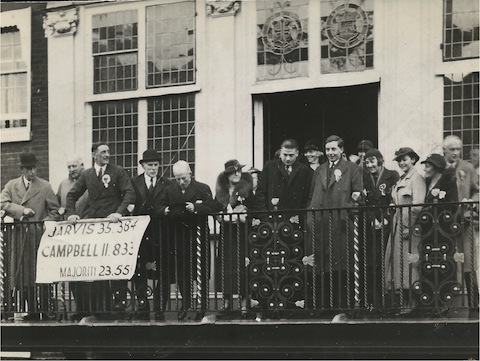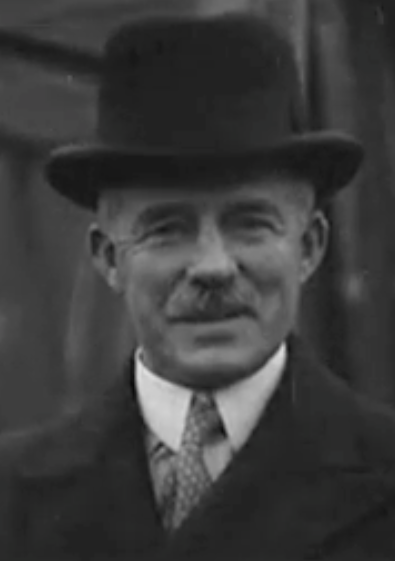 Abraham Lincoln
If given the truth, the people can be depended upon to meet any national crisis...
Abraham Lincoln
If given the truth, the people can be depended upon to meet any national crisis...
 Guildford news...
for Guildford people, brought to you by Guildford reporters - Guildford's own news service
Guildford news...
for Guildford people, brought to you by Guildford reporters - Guildford's own news service
Parke’s People No.8. Sir John Jarvis
Published on: 6 Oct, 2012
Updated on: 12 Oct, 2012
In the latest of an occasional series about people who have a connection with Guildford in one way or another, Bernard Parke recalls industrialist and former Guildford MP Sir John Jarvis.
Sir John Jarvis
I wonder how many Guildfordians born at the Jarvis nursing home in Stoughton Road have ever heard of the man that it was named after – Sir John Jarvis MP?
Sir John was elected High Sheriff of Surrey in 1934 and became Conservative MP for Guildford in 1935. He represented the town in the House of Commons until he retired from Parliament in 1950.
Like many people in the south of the country during the depressed days of the 1930s, he was concerned over the hardships people in the North East were experiencing due to the slump in shipbuilding. Previously, Britain had led the world in building ocean-going ships.
Sir John decided to do what he could to relieving the suffering of the people of Jarrow. It was the era of the Jarrow Crusade and also a time when scores of unemployed men came south hoping to find work. Some of those from the North East and South Wales were instrumental in building Guildford projects such as the lido and the bypass.
Many of the those who came eventually stayed and raised their families here. However, Sir John believed it to be a better policy to take work to the depressed areas, than for them to leave their own environments.
He founded the Surrey Fund, and in doing so raised £40,000 which provided employment in the north for the building of local amenities.

The result of the poll in Guildford for the 1935 general election is announced. Sir John Jarvis appears to be pictured fifth from left, the bald-headed man who has just removed his hat. He won by a sizable majority – more than 23,550. Picture: David Rose collection.
He was an extremely wealthy industrialist and purchased for £100,000 the ageing liner RMS Olympic, the sister ship of the ill-fated White Star line RMS Titanic. It was taken to Tyneside and provided work for hundreds of men who broke it up for scrap.
In 1938 Sir John also obtained the liner Berengaria, which again was broken up and provided work for men on Tyneside.
The Berengaria had been moored at Southampton. It was steamed around the coast, up the River Tyne to Jarrow, and on to M. T Ward & Co’s base at Palmer’s shipyard. It took until 1946 to complete the breaking up of the liner.
Despite the inclement weather on the day the ship arrived, it was received on Tyneside by thousands of spectators, include the the Mayor of Jarrow and other local dignities.
Scrap from both ships was used in Sir John’s new metal industries. He took no share in the profits, all the cash going to the welfare of the people.
Sir John made his home at Hascombe Court near Godalming in 1921. He lived there until his death in 1950 at the age of 74.
He was a man who had great concern for the sufferings of others, and without hesitation used his wealth to give some relief to their plight. A rare quality in today’s world.
Responses to Parke’s People No.8. Sir John Jarvis

Click on cartoon for Dragon story: Public Asked for Views on SCC’s Proposal for Reduced Speed Limits



Recent Articles
- SCC Calls on the Government To Protect the Environment
- Two-Week Road Closure on Portsmouth Road for Gas Network Upgrade
- Charlotteville Cycle Club Organises Another Successful Cycle Race Event
- Waverley Council To Bring Green Space Maintenance In-house
- A New Dementia Centre for Guildford
- Lib Dems Easily Hold Three Council Seats in Surrey By-elections
- UK Students to Launch International Space Mission
- New Skate Park Proposed for Cranleigh
- Retrofit Planned for Guildford Office Building
- Museum Shines a Light on Victorian Send, Ripley and Pyrford



Recent Comments
- Richard Cooke on Letter: Snail-paced Progress for Full Weir Repair
- Bethan Moore on Guildford’s First “Bike Bus”
- Andy Friend-Smith on Guildford’s First “Bike Bus”
- Peter Mills on Guildford’s First “Bike Bus”
- Des Flanders on Making History As Pewley School’s Class of ’54 Hold Their Final Reunion
- Margaret Rotherham on Guildford Festival Burst with Colour, Culture and Community Spirit
Search in Site
Media Gallery
Dragon Interview: Local Artist Leaves Her Mark At One of England’s Most Historic Buildings
January 21, 2023 / No Comment / Read MoreDragon Interview: Lib Dem Planning Chair: ‘Current Policy Doesn’t Work for Local People’
January 19, 2023 / No Comment / Read MoreA3 Tunnel in Guildford ‘Necessary’ for New Homes, Says Guildford’s MP
January 10, 2023 / No Comment / Read More‘Madness’ for London Road Scheme to Go Ahead Against ‘Huge Opposition’, Says SCC Leader
January 6, 2023 / No Comment / Read MoreCouncillor’s Son Starts Campaign for More Consultation on North Street Plan
December 30, 2022 / No Comment / Read MoreCounty Council Climbs Down Over London Road Works – Further ‘Engagement’ Period Announced
December 14, 2022 / No Comment / Read MoreDragon Interview: GBC Reaction to the Government’s Expected Decision to Relax Housing Targets
December 7, 2022 / No Comment / Read MoreHow Can Our Town Centre Businesses Recover? Watch the Shop Front Debate
May 18, 2020 / No Comment / Read More







Malcolm Wyatt
October 6, 2012 at 11:04 am
I am sure I’m not alone, as one of the many thousands born at the Jarvis Maternity Home, in knowing very little about the man who gave his name to my birthplace before being informed by this article. I see also that his garden in Hascombe was designed by Gertrude Jekyll. Judging by his achievements, I would suggest Sir John’s heart was definitely in the right place, irrespective of his party political colours.
Pete Brayne
October 6, 2012 at 4:05 pm
Bernard,
Thanks for this fascinating article.
Can I ask if you know how High Sheriffs were ‘elected’ in those days?
Trevor Wicks
October 8, 2012 at 7:53 am
Very interesting. What a man.
Bernard Parke
October 9, 2012 at 2:50 pm
Dear Pete,
Each County selects three names to the Queen who then picks one of those names to be High Sheriff.
This procedure has been with us for hundred of years.